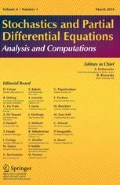Abstract
We consider a doubly nonlinear evolution equation with multiplicative noise and show existence and pathwise uniqueness of a strong solution. Using a semi-implicit time discretization we get approximate solutions with monotonicity arguments. We establish a-priori estimates for the approximate solutions and show tightness of the sequence of image measures induced by the sequence of approximate solutions. As a consequence of the theorems of Prokhorov and Skorokhod we get a.s. convergence of a subsequence on a new probability space which allows to show the existence of martingale solutions. Pathwise uniqueness is obtained by an \(L^1\)-method. Using this result, we are able to show existence and uniqueness of strong solutions.
Similar content being viewed by others
References
Adams, R.A.: Sobolev Spaces, vol. 65. Academic Press, New York (1975)
Banas, L., Brzezniak, Z., Neklyudov, M., Prohl, A.: A convergent finite-element-based discretization of the stochastic Landau–Lifshitz–Gilbert equation. IMA J. Numer. Anal. 34(2), 502–549 (2014)
Billingsley, P.: Convergence of Probability Measures. Wiley, New York (1999)
Breit, D., Feireisl, E., Hofmanova, M.: Stochastically Forced Compressible Fluid Flows. De Gruyter Series in Applied and Numerical Mathematics. De Gruyter, Berlin (2018)
Da Prato, G., Zabczyk, J.: Stochastic equations in infinite dimensions. Encyclopedia of Mathematics and Its Applications, 2nd edn. Cambridge University Press, Cambridge (1992)
Debussche, A., Hofmanová, M., Vovelle, J.: Degenerate parabolic stochastic partial differential equations: quasilinear case. Ann. Probab. 44(3), 1916–1955 (2016)
Diaz, J.I., de Thélin, F.: On a nonlinear parabolic problem arising in some models related to turbulent flows. SIAM J. Math. Anal. 25(4), 1085–1111 (1994)
Edwards, R.E.: Functional Analysis. Dover Publications Inc, New York (1995)
Flandoli, F., Gatarek, D.: Martingale and stationary solutions for stochastic Navier–Stokes equations. Probab. Theory Relat. Fields 102(3), 367–391 (1995)
Garsia, A., Rodemich, H., Rumsey, H.: A real variable lemma and the continuity of paths of some Gaussian processes. Indiana Univ. Math. J. 20, 565–578 (1970/71)
Gyöngy, I., Krylov, N.: Existence of strong solutions for Itô’s stochastic equations via approximations. Probab. Theory Relat. Fields 105(2), 143–158 (1996)
Hofnanová, M.: Degenerate parabolic stochastic partial differential equations. Stoch. Process. Appl. 123(12), 4294–4336 (2013)
Krylov, N.V., Rozovskiĭ, B.L.: Stochastic evolution equations. In: Stochastic Differential Equations: Theory and Applications, vol. 2 of Interdiscip. Math. Sci., pp. 1–69, World Sci. Publ., Hackensack (2007)
Lions, J.-L.: Quelques méthodes de résolution desproblèmes aux limites non linéaires. Dunod. Paris (1969)
Mielke, A., Rossi, R., Savaré, G.: Nonsmooth analysis of doubly nonlinear evolution equations. Calc. Var. Partial Differ. Equ. 46(1–2), 253–310 (2013)
Pardoux, E.: Équations aux dérivées partielles stochastiques non linéaires monotones. Ph.D. thesis, University of Paris Sud (1975)
Prévôt, C., Röckner, M.: A Concise Course on Stochastic Partial Differential Equations. Lecture Notes in Mathematics, vol. 1905. Springer, Berlin (2007)
Ruzicka, M.: Nichtlineare Funktionalanalysis. Eine Einführung. Springer, Berlin (2004)
Temam, R.: Navier-Stokes Equations. Theory and Numerical Analysis. North-Holland Publishing Co., Amsterdam (1977)
van der Vaart, A.W., Wellner, J.A.: Weak Convergence and Empirical Processes. Springer, New York (1996)
Visintin, A.: Two-scale model of phase transitions. Phys. D 106(1–2), 66–80 (1997)
Visintin, A.: Introduction to Stefan-Type Problems. Handbook of Differential Equations: Evolutionary Equations. Vol. IV, 377–484, Handb. Differ. Equ., Elsevier/North-Holland (2008)
Visintin, A.: Electromagnetic processes in doubly-nonlinear composites. Commun. Partial Differ. Equ. 33(4–6), 808–841 (2008)
Yamada, T., Watanabe, S.: On the uniqueness of solutions of stochastic differential equations. J. Math. Kyoto Univ. 11(1), 155–167 (1971)
Zeidler, E.: Nonlinear Functional Analysis and Its Applications II/B: Nonlinear Monotone Operators. Springer, New York (1990)
Zimmermann, A.: On a pseudomonotone evolution equation with multiplicative noise. In: Zimmermann, A., On nonlinear evolution problems with stochastic forcing, pp. 78–136. Habilitation thesis, University of Duisburg-Essen (2017)
Author information
Authors and Affiliations
Corresponding author
Appendix
Appendix
Theorem 7.1
Let \(a: D \times \mathbb {R}^d \rightarrow \mathbb {R}^d\) and \(b: \mathbb {R} \rightarrow \mathbb {R}\) as in Sect. 2. Then the operator \(A: W_0^{1,p}(D) \rightarrow W^{-1,p'}(D)\), \(Au = -div ~ a( \cdot , \nabla (b^{-1}(u)))\) is pseudomonotone.
Proof
Let \(u_n \rightharpoonup u \) in \(W_0^{1,p}(D)\) and \(\limsup \limits _{n \rightarrow \infty } \langle Au_n,u_n - u\rangle \le 0\).
Then we have
Here we used that \((b^{-1})'>0\), a is monotone and \((b^{-1})'(u_n) \rightarrow (b^{-1})'(u)\) in \(L^p(D)\).
Therefore we obtain \(\liminf \limits _{n \rightarrow \infty } \langle Au_n, u_n - u \rangle \ge 0\).
By using the assumption we may conclude \(\lim \limits _{n \rightarrow \infty } \langle Au_n, u_n - u \rangle =0\).
Now let \(w \in W_0^{1,p}(D)\) and set \(z=u + t(w-u)\), \(t>0\). It follows that \(z \rightarrow u\) in \(W_0^{1,p}(D)\) for \(t \rightarrow 0^+\). We obtain:
Therefore it follows
Now we take the limit inferior on both sides of the inequality. Since a is monotone we may conclude
We divide by t and get
By passing to the limit \(t \rightarrow 0^+\) we get:
Hence, A is pseudomonotone.
Rights and permissions
About this article
Cite this article
Sapountzoglou, N., Wittbold, P. & Zimmermann, A. On a doubly nonlinear PDE with stochastic perturbation. Stoch PDE: Anal Comp 7, 297–330 (2019). https://doi.org/10.1007/s40072-018-0128-7
Received:
Revised:
Published:
Issue Date:
DOI: https://doi.org/10.1007/s40072-018-0128-7




